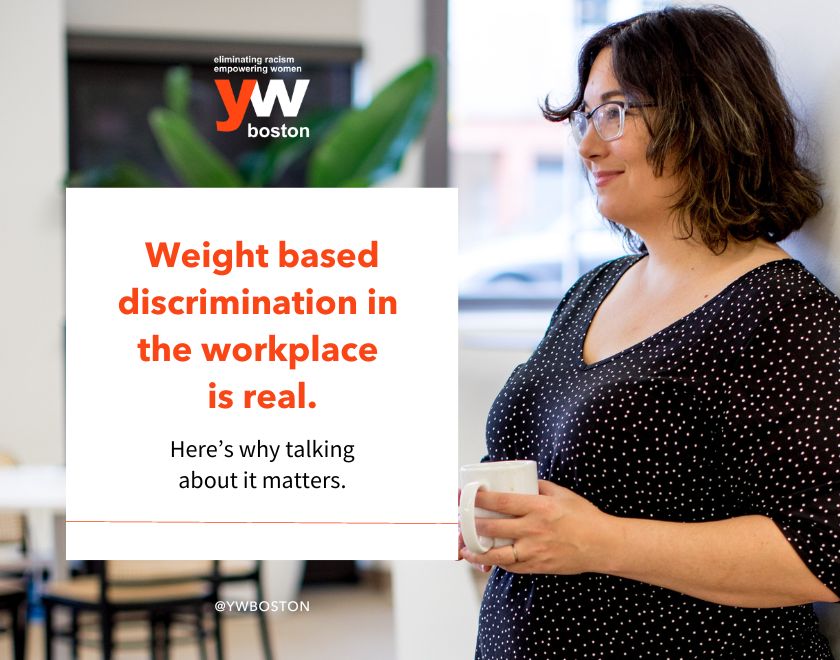
November 29, 2021
By: Jordan Ziese, Advocacy and Public Policy Senior Coordinator
Advocacy, Diversity, Equity, & Inclusion, Gender Equity, Intersectionality, Racial Equity, The Leader
Weight based discrimination in the workplace is real. Here’s why talking about it matters.
A note on terms: Activist and author Aubrey Gordon, known for most of her career under the pen name Your Fat Friend, notes that the recent uptick in conversations about body size in the past several years has caused some confusion around terminology. She eschews terms like sizeism, fat-shaming, and even fatphobia in favor of anti-fat or anti-fat bias to describe “‘the attitudes, behaviors, and social systems that specifically marginalize, exclude, underserve, and oppress fat bodies.’ They refer both to individual bigoted beliefs as well as institutional policies designed to marginalize fat people.” For that reason those terms will be used in this blog.
In the past year conversations about our bodies’ weights have taken center stage. From debates about whether a person’s BMI should determine when they are eligible for COVID-19 vaccines, to quippy jokes about the “quarantine 15”, to the revival of body positive activism on social media platforms there is clearly urgency around the discussion of weight stigma. These debates are nothing new, as anti-fat attitudes in the United States stretch back to the 17th century and fat liberation activism has been actively ongoing since the 1970s. These experiences are deeply intersectional and intertwined with racist, sexist, and ableist attitudes and policies.
Often considered a delicate and sensitive subject, it may feel uncomfortable or even rude to talk about anti-fat attitudes in the workplace. However, studies increasingly show that people in larger bodies are treated differently and paid less than their straight sized counterparts. Fat individuals face hurdles as small as not having accessible clothing options and as large as facing medical bias that can have disastrous consequences. If we do not discuss anti-fat attitudes as part of diversity, equity, and inclusion work, the problem will only persist and harm those already most marginalized in our workplaces. In order for everyone to thrive we must entertain the uncomfortable.
YW Boston recently joined the support of S.1127 /H.1822 “An Act Prohibiting Body Size Discrimination,” in the Massachusetts legislature. In our support of this bill, we invite you to learn more about history of anti-fat bias, body positive advocacy, and steps you can take to make your workplace more equitable for people of all sizes.
The roots of anti-fat bias are intertwined with systemic racism
Sociologist Sabrina Strings began her research wanting to trace the change of aesthetic preferences in the Western world from more voluptuous figures to slimmer bodies. What she found was a dark and twisted story of race, gender, and class at the root of our culture’s anti-fat attitudes, stating “our current aesthetic system, which suggest that white slender bodies, especially women’s bodies, are valuable, but fat bodies, and especially fat Black bodies, are worth denigration.” In her 2019 book Fearing the Black Body: The Racial Origins of Fatphobia Strings explains how White anxieties around upholding racial hierarchies led to the stigma of fatness as signifying a lack of self-control, thereby lending credence to their claims of supremacy, creating a “racialized ideal of thinness.” Throughout the centuries, tools and practices to codify who is thin and good and who is fat and bad have been created, adapted, and weaponized against those in larger bodies.
The primary tool used to measure fatness and uphold thin Whiteness as the standard body is still widely used today: the Body Mass Index (BMI). The BMI has been increasingly scrutinized as an inadequate measure of a person’s health for decades in parts of the medical community. This tool emerged out of racist pseudoscience in the 19th century and now disproportionately punishes and harms women, people of color, and especially women of color today.
The BMI’s architect, Lambert Adolphe Jacques Quetelet imagined the tool in his capacity as a mathematician to make observations about entire population. In crafting the BMI Quetelet used only French and Scottish people as subjects, wanting to capture the dimensions of an ideal, average white man whom he believed to be the standard.
By the mid 20th century life insurance companies took up a version of Quetelet’s work to create actuarial tables and set premiums. Only in the 1950s did physicians begin using these measurements as a way to quickly and inexpensively take a standardized snapshot of a person’s health, and by 1995 the World Helth Organization solidified the BMI as the global measurement of obesity. In the centuries since, this standard based on solely the physiques of White Europeans, has been used to oppress people around the world inhabiting all kinds of bodies, including the ones that fell out of Quetelet’s “ideal.” Measuring tools like the BMI are not ahistorical nor infallible.
An untold history of resistance
In the 1970s organizers Judy Freespiring and Sarah Fishman founded the Fat Underground, an organization devoted to exposing anti-fat attitudes, practices, and policies in the medical field. An explicitly feminist movement, these organizers saw their fatness as part of the intersecting oppressions they faced. Writing in their Fat Liberation Manifesto “We believe that fat people are fully entitled to human respect and recognition. We are angry at the mistreatment by commercial and sexist interests… We see our struggle as allied with the struggle of other oppressed groups, against classism, racism, sexism.”
Though the group disbanded in the 1980s, the echos of their work can be seen across the Health at Every Size movement which works to undo the harms done to the fat community during the medical community’s crusade against the “obesity epidemic.” As they state, “Fighting fat hasn’t made the fat go away. And being thinner, even if we knew how to successfully accomplish it, will not necessarily make us healthier or happier. The war on obesity has taken its toll.” We have yet to see the inclusion of all sized bodies that the Fat Underground imagined over 40 years ago.
Today activists and organizers like Aubrey Gordon are working to change attitudes, culture, and policy. In Gordon’s recent book she writes “I did not come to body positivity for self- esteem. I came to it for social justice.” Citing the myriad of systemic barriers fat people face to healthcare, employment, and justice the work of Gordon and her peers highlights the need for us to take bold steps towards dismantling anti-fatness in our organizations.
You can address weight based discrimination at work
It is becoming increasingly well documented that people with larger bodies face discrimination in their workplaces, and have little recourse to seek justice. This discrimination has a disproportionate impact on women, people of color, and especially women of color who are already facing systemic disadvantages in the workplace. A 2011 study found that for each one unit increase in BMI women made 1.83% less, which could lead to thousands of dollars in lost wages over a lifetime. A 2016 study found that hiring managers treat larger candidates less favorably than their thin counterparts. A review of the Harvard IAT test for implicit weight bias found a 40% increase in negative fat attitudes in the early 2000s, while implicit bias measures towards other marginalized groups have become more positive over time. In all, 42% of fat individuals report facing some kind of discrimination as a result of their size, and the larger a person is, the more discrimination they report facing. In our workplaces and our world anti-fat attitudes have clear and direct consequences on the lives of fat people.
So, what are we to do? A good first step is to educate yourself and your employees on how you view people in larger bodies. Beyond that we must consider how our workplaces feel to those in larger bodies. This ranges from the material culture of office furniture to the psychological stress of office wellness challenges. The following list is a starting point to have larger conversations about anti-fat bias in our workplaces and society.
- Consider taking the weight IAT test for weight to see what your implicit bias is towards fat individuals.
- Ensure that your office is accessible for people at all sizes by providing comfortably sized furniture, and devoid of architecture that may be hostile towards people of larger body sizes.
- During your next staff outing, be sure to pick an activity that wouldn’t exclude someone based on their weight.
- Examine your workplace policies around hiring and promotion to ensure that people of all sizes are treated equitably in the process.
- Include weight-based discrimination and bullying in guides about inappropriate workplace behavior.
- Consider eliminating weight-based workplace “wellness programs” that are not shown to be effective at achieving positive health outcomes and may actively harm fat employees.
- Consider using more positive images of larger people in your communications. The UConn Rudd Center for Food Policy & Health has a Media Gallery.
Finally, as an individual you can consider supporting initiatives and legislation that seeks to ban weight based discrimination in work and public spaces. Contact your legislator and ask them to support S.1127 /H.1822 “An Act Prohibiting Body Size Discrimination” and check out the resources from the STRIPED initiative working to end weight based discrimination. Anti-fat bias is a pervasive force within our world and requires a dynamic response to confront our own individual biases and dismantle systemic barriers faced by those in larger bodies.
We suggest you continue learning more about this expansive topic. These resources as good places to start.
- Listen to the Maintenance Phase Podcast hosted by Aubrey Gordon and Michael Hobbes
- Read Fearing the Black Body: The Racial Origins of Fat Phobia by Sabrina Strings
- Read Belly of the Beast: The Politics of Anti-fatness as Anti-blackness by Da’Shaun Harrison
- Read What We Don’t Talk About When We Talk About Fat by Aubrey Gordon
- Familiarize yourself with the research and resources from the UConn Rudd Center for Food Policy & Health around Weight Bias & Stigma.
______
About YW Boston
As the first YWCA in the nation, YW Boston has been at the forefront of advancing equity for over 150 years. Through our DEI Services—such as DEI Consulting and Training Services and LeadBoston—as well as our advocacy work and F.Y.R.E. Initiative, we help individuals and organizations change policies, practices, attitudes, and behaviors with a goal of creating more inclusive environments where women, people of color, and especially women of color can succeed.
YW Boston Advocacy Committee
The Advocacy Committee supports YW Boston’s mission to eliminate racism and empower women by engaging elected officials, organizations and the public through legislative advocacy, coalition building, education, and action. The committee develops and implements the organization’s two-year advocacy agenda in order to rectify structural barriers to equity and opportunity for women, girls, and people of color.

